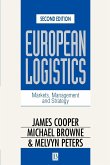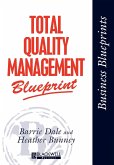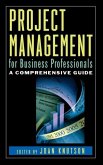Kent N. Gourdin
Global Logistics Management 2e
Kent N. Gourdin
Global Logistics Management 2e
- Broschiertes Buch
- Merkliste
- Auf die Merkliste
- Bewerten Bewerten
- Teilen
- Produkt teilen
- Produkterinnerung
- Produkterinnerung
A second edition of this clear and straightforward introduction to global logistics management.
Helps readers to understand and appreciate the power of managing logistics for profit and competitive advantage.
This second edition of Global Logistics Management has been thoroughly revised and updated, and new examples have been added reflecting recent developments in the field. This new edition: Helps readers to understand and appreciate the power of managing logistics for profit and competitive advantage Educates readers about the nature of individual logistics activities and how they can…mehr
Andere Kunden interessierten sich auch für
![Operations Management Operations Management]() John BichenoOperations Management91,99 €
John BichenoOperations Management91,99 €![European Logistics European Logistics]() Jim CooperEuropean Logistics67,99 €
Jim CooperEuropean Logistics67,99 €![Human Resource Management 2e Human Resource Management 2e]() Christopher MabeyHuman Resource Management 2e99,99 €
Christopher MabeyHuman Resource Management 2e99,99 €![Total Quality Management Bluep Total Quality Management Bluep]() Barrie DaleTotal Quality Management Bluep61,99 €
Barrie DaleTotal Quality Management Bluep61,99 €![Cooperative Strategy Cooperative Strategy]() Pierre DussaugeCooperative Strategy113,99 €
Pierre DussaugeCooperative Strategy113,99 €![Project Management for Business Professionals Project Management for Business Professionals]() Joan KnutsonProject Management for Business Professionals146,99 €
Joan KnutsonProject Management for Business Professionals146,99 €![Managing People and Activities Managing People and Activities]() Tom BurdenManaging People and Activities27,99 €
Tom BurdenManaging People and Activities27,99 €-
-
-
A second edition of this clear and straightforward introduction to global logistics management.
Helps readers to understand and appreciate the power of managing logistics for profit and competitive advantage.
This second edition of
Global Logistics Management has been thoroughly revised and updated, and new examples have been added reflecting recent developments in the field. This new edition:
Helps readers to understand and appreciate the power of managing logistics for profit and competitive advantage
Educates readers about the nature of individual logistics activities and how they can be woven together
Contains a global focus throughout, with examples drawn from various parts of the world
Has been thoroughly revised and updated throughout to keep it current
Now includes new examples reflecting recent developments and current preoccupations, including security and global instability.
Visit the accompanying website at www.blackwellpublishing.com/gourdin to download PowerPoint slides to supplement the book.
Hinweis: Dieser Artikel kann nur an eine deutsche Lieferadresse ausgeliefert werden.
Helps readers to understand and appreciate the power of managing logistics for profit and competitive advantage.
This second edition of
Global Logistics Management has been thoroughly revised and updated, and new examples have been added reflecting recent developments in the field. This new edition:
Helps readers to understand and appreciate the power of managing logistics for profit and competitive advantage
Educates readers about the nature of individual logistics activities and how they can be woven together
Contains a global focus throughout, with examples drawn from various parts of the world
Has been thoroughly revised and updated throughout to keep it current
Now includes new examples reflecting recent developments and current preoccupations, including security and global instability.
Visit the accompanying website at www.blackwellpublishing.com/gourdin to download PowerPoint slides to supplement the book.
Hinweis: Dieser Artikel kann nur an eine deutsche Lieferadresse ausgeliefert werden.
Produktdetails
- Produktdetails
- Blackwell Business
- Verlag: Blackwell Publishers
- 2nd Edition
- Seitenzahl: 352
- Erscheinungstermin: 10. Februar 2006
- Englisch
- Abmessung: 244mm x 170mm x 19mm
- Gewicht: 610g
- ISBN-13: 9781405127134
- ISBN-10: 1405127139
- Artikelnr.: 20898284
- Herstellerkennzeichnung
- Libri GmbH
- Europaallee 1
- 36244 Bad Hersfeld
- gpsr@libri.de
- Blackwell Business
- Verlag: Blackwell Publishers
- 2nd Edition
- Seitenzahl: 352
- Erscheinungstermin: 10. Februar 2006
- Englisch
- Abmessung: 244mm x 170mm x 19mm
- Gewicht: 610g
- ISBN-13: 9781405127134
- ISBN-10: 1405127139
- Artikelnr.: 20898284
- Herstellerkennzeichnung
- Libri GmbH
- Europaallee 1
- 36244 Bad Hersfeld
- gpsr@libri.de
Kent N. Gourdin is Director of the Global Logistics and Transportation Program in the School of Business and Economics at the College of Charleston. He also holds the Henry Tecklenburg Chair in Intermodal Transportation.
Preface xiii
Acknowledgments xv
1 Introduction to Logistics 1
Logistics: The Historical Perspective 1
Logistics: The Modern Perspective 2
Components of a logistics system 4
The role of logistics in the organization 7
Logistics as a Source of Competitive Advantage 8
Why Is Management Interest in Logistics Growing? 10
Trends in global trade 10
Customers are demanding greater value 10
Transportation privatization and liberalization 11
Transportation security 12
Environmental concerns 12
Changing view of inventory 13
Continuing advances in information technology 14
Electronic commerce 15
Logistics in the Global Organization 15
Conceptual Model and Statement of Purpose 17
Chapter Summary 18
Study Questions 19
2 Logistics in the Organization 21
Introduction 21
The Marketing/Logistics Partnership 22
Marketing and Logistics Channels 22
Alternative channel structures 22
Why do channels develop? 23
Channel flows 23
Designing effective channels 25
Environmental Issues 25
Marketing Issues 26
Channel management issues 31
Formal and informal channel relationships 32
Domestic versus global channels 33
Future trends in channel structures 35
Managing the Logistics System 36
Tradeoff Analysis 37
Enhancing Corporate Profitability with Logistics 39
Chapter Summary 41
Study Questions 42
3 Customer Service 44
Introduction 44
What Is Customer Service? 45
Elements of Customer Service 45
Customer Service in a Global Setting 49
How Much Service Should Be Offered? 50
Barriers to Quality Customer Service 52
Controllable factors 52
Uncontrollable factors 53
Improving Customer Service Performance 54
The Consequences of Poor Customer Service 55
Improving Customer Service in Comparison to its Costs 59
Customer Service and the Internal Customer 59
Chapter Summary 60
Study Questions 60
4 Inventory Management 62
Introduction 62
Inventory and Customer Service 63
Purposes of Inventory 64
Types of Inventory 64
Objectives of Inventory Management 65
Inventory costs 65
Managing inventory costs 66
Classic Inventory Models 66
Economic order quantity (EOQ) model 66
Modifications to the basic EOQ model 67
Model limitations 68
Fixed order point/fixed order quantity model 68
Fixed order interval model 68
Safety stock requirements 70
Inventory Management: Signs of Trouble 71
Improving Inventory Management 74
Materials Requirements Planning (MRP) 77
Distribution Resource Planning (DRP) 77
Just-In-Time (JIT) Inventory Management 77
Basic tenets of JIT 78
Advantages of JIT 79
Disadvantages of JIT 79
JIT II/vendor managed inventory (VMI) 80
The reality of JIT 81
Integrated Inventory Management: DRP, MRP, and JIT 82
Inventory Management in a Global Market 83
Chapter Summary 85
Study Questions 86
5 Global Transportation Systems 87
Introduction 87
The Five Modes of Transportation 88
Rail 89
Road transport 91
Pipelines 93
Air 93
Water carriage 94
Deregulation and Privatization of Transportation 97
Deregulation 97
Privatization 98
Future directions 99
Government's Role in Transportation 100
Direct control and regulation of transport firms 100
Provision of transport infrastructure 101
Promulgating and enforcing environmental, safety, and security laws 101
Transportation Security 102
Intermodal Transportation 103
Rail 104
Ocean transport 104
Air 105
Motor transport 105
Infrastructure issues 106
Concluding comments 106
Chapter Summary 106
Study Questions 107
6 Transportation Management Issues 109
Introduction 109
Developing Win/Win Shipper/Carrier Relationships 109
Transport Pricing 111
Market structure models 111
Relevant market area 112
Shipper demand 113
Carrier costs 113
Pricing in Practice 115
Price negotiation: the carrier's perspective 115
Price negotiation: the shipper's perspective 116
Private Transportation 116
Other Issues Affecting Transportation Cost and Service 117
Infrastructure availability and condition 117
Environmental and quality of life issues 121
Customs and cargo security 125
Carrier safety 125
Conclusions 126
Chapter Summary 126
Study Questions 127
7 Warehousing 129
Introduction 129
The Strategic Role of Warehousing in Logistics 131
Functions of Warehousing 132
Warehouse Roles 134
Warehouse Location Issues 135
Centralized versus decentralized warehouses 135
Selecting specific sites 137
Warehousing Alternatives 139
Private warehousing 139
Contract warehousing 139
Public warehouses 139
Warehousing Strategies 140
Warehousing Concerns in Overseas Markets 141
Chapter Summary 143
Study Questions 143
8 Materials Handling and Packaging 145
Introduction 145
Basic Warehouse Design 145
Manual Versus Automated Materials Handling Systems 146
Manual warehouses 146
Automated warehouses 147
Manual versus automated: making the choice 147
Trends in Materials Handling 150
Reliability 150
Total integration 151
Flexibility and modularity 151
Upgradeability 151
Automated identification 152
Ease of use 155
Maintainability 155
Conclusions 155
Product Packaging 156
Types of packaging 156
Organizational influences on packaging 156
The role of packaging 157
Logistics packaging materials 157
Environmental issues 158
Packaging for global markets 159
Bar coding 160
Developments in packaging 161
Tradeoffs with other components of the logistics system 161
Chapter Summary 163
Study Questions 163
9 Managing Logistics Information 166
Introduction 166
The Order Processing System 167
Logistics Information Systems 168
Environmental scanning 169
LIS and information management 169
Forecasting Methods 170
Qualitative forecasts 170
Time-series methods 170
Causal methods 171
Forecasting logistics needs 172
Selecting the right forecasting technique 172
Using Information to Link a Global Logistics System Together 172
Electronic data interchange (EDI) 172
Impediments to global implementation of EDI procedures 178
Developments in Logistics Information Systems 178
The Internet and electronic commerce 179
Open-systems computer networks 180
Wireless communication 180
Multidimensional bar codes 180
Radio frequency identification (RFID) technology 180
Other advances in communications 182
Chapter Summary 182
Study Questions 183
10 Inbound Logistics and Purchasing 185
Introduction 185
The Growing Importance of Inbound Logistics 186
Inbound Logistics Activities 187
Customer service 187
Transportation 187
Inventory management 187
Warehousing and storage 188
Maintenance 188
Information management 188
Salvage and waste disposal 189
Production 189
Summary 189
Purchasing 190
Goals of purchasing 191
Purchasing tasks 191
Improving purchasing productivity 194
Organize for enhanced productivity 197
Management Techniques for Improving Materials Management 200
Chapter Summary 200
Study Questions 200
11 The Global Logistics Environment 203
Introduction 203
The Global Supply Chain 204
Changing Market Opportunities 205
Emerging nations 205
Multilateral trade organizations 205
Global sourcing 208
Cultural Issues in Logistics 208
Alternative Global Distribution Strategies 209
International Documentation 211
Customs Regulations 212
Foreign Trade Zones 214
Logistics Intermediaries and Facilitators 215
Third-Party Logistics Providers 217
Controlling the Global Logistics System 219
Chapter Summary 220
Study Questions 221
12 Logistics Strategies 224
Introduction 224
Corporate Strategic Planning 225
Formulating Logistics Strategy 226
Integrating the Logistics Channel 230
Implementing Logistics Strategies 232
Centralization of logistics activities versus decentralization 233
Third-party service providers 234
Logistics strategy and improved corporate performance 237
Future Issues That Will Affect Logistics 237
Implications for Logistics Managers 241
Chapter Summary 242
Study Questions 242
13 Developing High-Quality Logistics Systems 245
Introduction 245
Basic Quality Concepts: The Internal Perspective 246
Leadership 247
Cooperation 247
Learning 248
Process management 248
Employee outcomes 248
Organizational performances 248
Basic Quality Concepts: The External View 249
The Service Quality Model 250
Total Quality Management (TQM) in Logistics 253
Developing a Formal Quality Process 254
Quality Process Success Factors for Logistics Management 256
ISO 9001:2000 The International Quality Standard 259
The Cost of Quality 260
Chapter Summary 260
Study Questions 261
14 Improving Logistics Performance 263
Introduction 263
Improving Organizational Performance 264
Continuous and breakthrough improvements 265
Basic Tools for Improving Logistics Performance 266
Process analysis tools 266
Statistical analysis tools 268
Benchmarking 268
Activity-based costing 270
Effecting Meaningful Change 274
Logistics service quality 274
Productivity 275
Process effectiveness 276
Impediments to Improved Logistics Performance 276
Failure to adopt the customer's viewpoint 276
Lack of requisite cost data 277
Lack of broad-based management skills 278
Failure to think of logistics as a system 278
Need for cultural change within the organization 279
Creating a World-Class Logistics System 279
Chapter Summary 281
Study Questions 282
15 Organizing for Logistics Effectiveness 284
Introduction 284
Overview of Logistics Organizations 285
Building an Effective Logistics Organization 288
Centralization 288
Scope of responsibility/span of control 289
Formalization 289
Integration 289
The Role of Logistics in the Firm 289
Inter-organizational effectiveness 290
Variables Influencing Organizational Structure 291
Organization size 292
Corporate structure 292
Corporate strategy 292
The importance of logistics 293
Corporate information technology 293
Environmental uncertainty 293
Environmental heterogeneity 294
Summary 297
Reconciling Intra- and Inter-Organizational Issues 298
Moving Towards the "Best" Organizational Structure 299
Chapter Summary 299
Study Questions 300
Index 303
Acknowledgments xv
1 Introduction to Logistics 1
Logistics: The Historical Perspective 1
Logistics: The Modern Perspective 2
Components of a logistics system 4
The role of logistics in the organization 7
Logistics as a Source of Competitive Advantage 8
Why Is Management Interest in Logistics Growing? 10
Trends in global trade 10
Customers are demanding greater value 10
Transportation privatization and liberalization 11
Transportation security 12
Environmental concerns 12
Changing view of inventory 13
Continuing advances in information technology 14
Electronic commerce 15
Logistics in the Global Organization 15
Conceptual Model and Statement of Purpose 17
Chapter Summary 18
Study Questions 19
2 Logistics in the Organization 21
Introduction 21
The Marketing/Logistics Partnership 22
Marketing and Logistics Channels 22
Alternative channel structures 22
Why do channels develop? 23
Channel flows 23
Designing effective channels 25
Environmental Issues 25
Marketing Issues 26
Channel management issues 31
Formal and informal channel relationships 32
Domestic versus global channels 33
Future trends in channel structures 35
Managing the Logistics System 36
Tradeoff Analysis 37
Enhancing Corporate Profitability with Logistics 39
Chapter Summary 41
Study Questions 42
3 Customer Service 44
Introduction 44
What Is Customer Service? 45
Elements of Customer Service 45
Customer Service in a Global Setting 49
How Much Service Should Be Offered? 50
Barriers to Quality Customer Service 52
Controllable factors 52
Uncontrollable factors 53
Improving Customer Service Performance 54
The Consequences of Poor Customer Service 55
Improving Customer Service in Comparison to its Costs 59
Customer Service and the Internal Customer 59
Chapter Summary 60
Study Questions 60
4 Inventory Management 62
Introduction 62
Inventory and Customer Service 63
Purposes of Inventory 64
Types of Inventory 64
Objectives of Inventory Management 65
Inventory costs 65
Managing inventory costs 66
Classic Inventory Models 66
Economic order quantity (EOQ) model 66
Modifications to the basic EOQ model 67
Model limitations 68
Fixed order point/fixed order quantity model 68
Fixed order interval model 68
Safety stock requirements 70
Inventory Management: Signs of Trouble 71
Improving Inventory Management 74
Materials Requirements Planning (MRP) 77
Distribution Resource Planning (DRP) 77
Just-In-Time (JIT) Inventory Management 77
Basic tenets of JIT 78
Advantages of JIT 79
Disadvantages of JIT 79
JIT II/vendor managed inventory (VMI) 80
The reality of JIT 81
Integrated Inventory Management: DRP, MRP, and JIT 82
Inventory Management in a Global Market 83
Chapter Summary 85
Study Questions 86
5 Global Transportation Systems 87
Introduction 87
The Five Modes of Transportation 88
Rail 89
Road transport 91
Pipelines 93
Air 93
Water carriage 94
Deregulation and Privatization of Transportation 97
Deregulation 97
Privatization 98
Future directions 99
Government's Role in Transportation 100
Direct control and regulation of transport firms 100
Provision of transport infrastructure 101
Promulgating and enforcing environmental, safety, and security laws 101
Transportation Security 102
Intermodal Transportation 103
Rail 104
Ocean transport 104
Air 105
Motor transport 105
Infrastructure issues 106
Concluding comments 106
Chapter Summary 106
Study Questions 107
6 Transportation Management Issues 109
Introduction 109
Developing Win/Win Shipper/Carrier Relationships 109
Transport Pricing 111
Market structure models 111
Relevant market area 112
Shipper demand 113
Carrier costs 113
Pricing in Practice 115
Price negotiation: the carrier's perspective 115
Price negotiation: the shipper's perspective 116
Private Transportation 116
Other Issues Affecting Transportation Cost and Service 117
Infrastructure availability and condition 117
Environmental and quality of life issues 121
Customs and cargo security 125
Carrier safety 125
Conclusions 126
Chapter Summary 126
Study Questions 127
7 Warehousing 129
Introduction 129
The Strategic Role of Warehousing in Logistics 131
Functions of Warehousing 132
Warehouse Roles 134
Warehouse Location Issues 135
Centralized versus decentralized warehouses 135
Selecting specific sites 137
Warehousing Alternatives 139
Private warehousing 139
Contract warehousing 139
Public warehouses 139
Warehousing Strategies 140
Warehousing Concerns in Overseas Markets 141
Chapter Summary 143
Study Questions 143
8 Materials Handling and Packaging 145
Introduction 145
Basic Warehouse Design 145
Manual Versus Automated Materials Handling Systems 146
Manual warehouses 146
Automated warehouses 147
Manual versus automated: making the choice 147
Trends in Materials Handling 150
Reliability 150
Total integration 151
Flexibility and modularity 151
Upgradeability 151
Automated identification 152
Ease of use 155
Maintainability 155
Conclusions 155
Product Packaging 156
Types of packaging 156
Organizational influences on packaging 156
The role of packaging 157
Logistics packaging materials 157
Environmental issues 158
Packaging for global markets 159
Bar coding 160
Developments in packaging 161
Tradeoffs with other components of the logistics system 161
Chapter Summary 163
Study Questions 163
9 Managing Logistics Information 166
Introduction 166
The Order Processing System 167
Logistics Information Systems 168
Environmental scanning 169
LIS and information management 169
Forecasting Methods 170
Qualitative forecasts 170
Time-series methods 170
Causal methods 171
Forecasting logistics needs 172
Selecting the right forecasting technique 172
Using Information to Link a Global Logistics System Together 172
Electronic data interchange (EDI) 172
Impediments to global implementation of EDI procedures 178
Developments in Logistics Information Systems 178
The Internet and electronic commerce 179
Open-systems computer networks 180
Wireless communication 180
Multidimensional bar codes 180
Radio frequency identification (RFID) technology 180
Other advances in communications 182
Chapter Summary 182
Study Questions 183
10 Inbound Logistics and Purchasing 185
Introduction 185
The Growing Importance of Inbound Logistics 186
Inbound Logistics Activities 187
Customer service 187
Transportation 187
Inventory management 187
Warehousing and storage 188
Maintenance 188
Information management 188
Salvage and waste disposal 189
Production 189
Summary 189
Purchasing 190
Goals of purchasing 191
Purchasing tasks 191
Improving purchasing productivity 194
Organize for enhanced productivity 197
Management Techniques for Improving Materials Management 200
Chapter Summary 200
Study Questions 200
11 The Global Logistics Environment 203
Introduction 203
The Global Supply Chain 204
Changing Market Opportunities 205
Emerging nations 205
Multilateral trade organizations 205
Global sourcing 208
Cultural Issues in Logistics 208
Alternative Global Distribution Strategies 209
International Documentation 211
Customs Regulations 212
Foreign Trade Zones 214
Logistics Intermediaries and Facilitators 215
Third-Party Logistics Providers 217
Controlling the Global Logistics System 219
Chapter Summary 220
Study Questions 221
12 Logistics Strategies 224
Introduction 224
Corporate Strategic Planning 225
Formulating Logistics Strategy 226
Integrating the Logistics Channel 230
Implementing Logistics Strategies 232
Centralization of logistics activities versus decentralization 233
Third-party service providers 234
Logistics strategy and improved corporate performance 237
Future Issues That Will Affect Logistics 237
Implications for Logistics Managers 241
Chapter Summary 242
Study Questions 242
13 Developing High-Quality Logistics Systems 245
Introduction 245
Basic Quality Concepts: The Internal Perspective 246
Leadership 247
Cooperation 247
Learning 248
Process management 248
Employee outcomes 248
Organizational performances 248
Basic Quality Concepts: The External View 249
The Service Quality Model 250
Total Quality Management (TQM) in Logistics 253
Developing a Formal Quality Process 254
Quality Process Success Factors for Logistics Management 256
ISO 9001:2000 The International Quality Standard 259
The Cost of Quality 260
Chapter Summary 260
Study Questions 261
14 Improving Logistics Performance 263
Introduction 263
Improving Organizational Performance 264
Continuous and breakthrough improvements 265
Basic Tools for Improving Logistics Performance 266
Process analysis tools 266
Statistical analysis tools 268
Benchmarking 268
Activity-based costing 270
Effecting Meaningful Change 274
Logistics service quality 274
Productivity 275
Process effectiveness 276
Impediments to Improved Logistics Performance 276
Failure to adopt the customer's viewpoint 276
Lack of requisite cost data 277
Lack of broad-based management skills 278
Failure to think of logistics as a system 278
Need for cultural change within the organization 279
Creating a World-Class Logistics System 279
Chapter Summary 281
Study Questions 282
15 Organizing for Logistics Effectiveness 284
Introduction 284
Overview of Logistics Organizations 285
Building an Effective Logistics Organization 288
Centralization 288
Scope of responsibility/span of control 289
Formalization 289
Integration 289
The Role of Logistics in the Firm 289
Inter-organizational effectiveness 290
Variables Influencing Organizational Structure 291
Organization size 292
Corporate structure 292
Corporate strategy 292
The importance of logistics 293
Corporate information technology 293
Environmental uncertainty 293
Environmental heterogeneity 294
Summary 297
Reconciling Intra- and Inter-Organizational Issues 298
Moving Towards the "Best" Organizational Structure 299
Chapter Summary 299
Study Questions 300
Index 303
Preface xiii
Acknowledgments xv
1 Introduction to Logistics 1
Logistics: The Historical Perspective 1
Logistics: The Modern Perspective 2
Components of a logistics system 4
The role of logistics in the organization 7
Logistics as a Source of Competitive Advantage 8
Why Is Management Interest in Logistics Growing? 10
Trends in global trade 10
Customers are demanding greater value 10
Transportation privatization and liberalization 11
Transportation security 12
Environmental concerns 12
Changing view of inventory 13
Continuing advances in information technology 14
Electronic commerce 15
Logistics in the Global Organization 15
Conceptual Model and Statement of Purpose 17
Chapter Summary 18
Study Questions 19
2 Logistics in the Organization 21
Introduction 21
The Marketing/Logistics Partnership 22
Marketing and Logistics Channels 22
Alternative channel structures 22
Why do channels develop? 23
Channel flows 23
Designing effective channels 25
Environmental Issues 25
Marketing Issues 26
Channel management issues 31
Formal and informal channel relationships 32
Domestic versus global channels 33
Future trends in channel structures 35
Managing the Logistics System 36
Tradeoff Analysis 37
Enhancing Corporate Profitability with Logistics 39
Chapter Summary 41
Study Questions 42
3 Customer Service 44
Introduction 44
What Is Customer Service? 45
Elements of Customer Service 45
Customer Service in a Global Setting 49
How Much Service Should Be Offered? 50
Barriers to Quality Customer Service 52
Controllable factors 52
Uncontrollable factors 53
Improving Customer Service Performance 54
The Consequences of Poor Customer Service 55
Improving Customer Service in Comparison to its Costs 59
Customer Service and the Internal Customer 59
Chapter Summary 60
Study Questions 60
4 Inventory Management 62
Introduction 62
Inventory and Customer Service 63
Purposes of Inventory 64
Types of Inventory 64
Objectives of Inventory Management 65
Inventory costs 65
Managing inventory costs 66
Classic Inventory Models 66
Economic order quantity (EOQ) model 66
Modifications to the basic EOQ model 67
Model limitations 68
Fixed order point/fixed order quantity model 68
Fixed order interval model 68
Safety stock requirements 70
Inventory Management: Signs of Trouble 71
Improving Inventory Management 74
Materials Requirements Planning (MRP) 77
Distribution Resource Planning (DRP) 77
Just-In-Time (JIT) Inventory Management 77
Basic tenets of JIT 78
Advantages of JIT 79
Disadvantages of JIT 79
JIT II/vendor managed inventory (VMI) 80
The reality of JIT 81
Integrated Inventory Management: DRP, MRP, and JIT 82
Inventory Management in a Global Market 83
Chapter Summary 85
Study Questions 86
5 Global Transportation Systems 87
Introduction 87
The Five Modes of Transportation 88
Rail 89
Road transport 91
Pipelines 93
Air 93
Water carriage 94
Deregulation and Privatization of Transportation 97
Deregulation 97
Privatization 98
Future directions 99
Government's Role in Transportation 100
Direct control and regulation of transport firms 100
Provision of transport infrastructure 101
Promulgating and enforcing environmental, safety, and security laws 101
Transportation Security 102
Intermodal Transportation 103
Rail 104
Ocean transport 104
Air 105
Motor transport 105
Infrastructure issues 106
Concluding comments 106
Chapter Summary 106
Study Questions 107
6 Transportation Management Issues 109
Introduction 109
Developing Win/Win Shipper/Carrier Relationships 109
Transport Pricing 111
Market structure models 111
Relevant market area 112
Shipper demand 113
Carrier costs 113
Pricing in Practice 115
Price negotiation: the carrier's perspective 115
Price negotiation: the shipper's perspective 116
Private Transportation 116
Other Issues Affecting Transportation Cost and Service 117
Infrastructure availability and condition 117
Environmental and quality of life issues 121
Customs and cargo security 125
Carrier safety 125
Conclusions 126
Chapter Summary 126
Study Questions 127
7 Warehousing 129
Introduction 129
The Strategic Role of Warehousing in Logistics 131
Functions of Warehousing 132
Warehouse Roles 134
Warehouse Location Issues 135
Centralized versus decentralized warehouses 135
Selecting specific sites 137
Warehousing Alternatives 139
Private warehousing 139
Contract warehousing 139
Public warehouses 139
Warehousing Strategies 140
Warehousing Concerns in Overseas Markets 141
Chapter Summary 143
Study Questions 143
8 Materials Handling and Packaging 145
Introduction 145
Basic Warehouse Design 145
Manual Versus Automated Materials Handling Systems 146
Manual warehouses 146
Automated warehouses 147
Manual versus automated: making the choice 147
Trends in Materials Handling 150
Reliability 150
Total integration 151
Flexibility and modularity 151
Upgradeability 151
Automated identification 152
Ease of use 155
Maintainability 155
Conclusions 155
Product Packaging 156
Types of packaging 156
Organizational influences on packaging 156
The role of packaging 157
Logistics packaging materials 157
Environmental issues 158
Packaging for global markets 159
Bar coding 160
Developments in packaging 161
Tradeoffs with other components of the logistics system 161
Chapter Summary 163
Study Questions 163
9 Managing Logistics Information 166
Introduction 166
The Order Processing System 167
Logistics Information Systems 168
Environmental scanning 169
LIS and information management 169
Forecasting Methods 170
Qualitative forecasts 170
Time-series methods 170
Causal methods 171
Forecasting logistics needs 172
Selecting the right forecasting technique 172
Using Information to Link a Global Logistics System Together 172
Electronic data interchange (EDI) 172
Impediments to global implementation of EDI procedures 178
Developments in Logistics Information Systems 178
The Internet and electronic commerce 179
Open-systems computer networks 180
Wireless communication 180
Multidimensional bar codes 180
Radio frequency identification (RFID) technology 180
Other advances in communications 182
Chapter Summary 182
Study Questions 183
10 Inbound Logistics and Purchasing 185
Introduction 185
The Growing Importance of Inbound Logistics 186
Inbound Logistics Activities 187
Customer service 187
Transportation 187
Inventory management 187
Warehousing and storage 188
Maintenance 188
Information management 188
Salvage and waste disposal 189
Production 189
Summary 189
Purchasing 190
Goals of purchasing 191
Purchasing tasks 191
Improving purchasing productivity 194
Organize for enhanced productivity 197
Management Techniques for Improving Materials Management 200
Chapter Summary 200
Study Questions 200
11 The Global Logistics Environment 203
Introduction 203
The Global Supply Chain 204
Changing Market Opportunities 205
Emerging nations 205
Multilateral trade organizations 205
Global sourcing 208
Cultural Issues in Logistics 208
Alternative Global Distribution Strategies 209
International Documentation 211
Customs Regulations 212
Foreign Trade Zones 214
Logistics Intermediaries and Facilitators 215
Third-Party Logistics Providers 217
Controlling the Global Logistics System 219
Chapter Summary 220
Study Questions 221
12 Logistics Strategies 224
Introduction 224
Corporate Strategic Planning 225
Formulating Logistics Strategy 226
Integrating the Logistics Channel 230
Implementing Logistics Strategies 232
Centralization of logistics activities versus decentralization 233
Third-party service providers 234
Logistics strategy and improved corporate performance 237
Future Issues That Will Affect Logistics 237
Implications for Logistics Managers 241
Chapter Summary 242
Study Questions 242
13 Developing High-Quality Logistics Systems 245
Introduction 245
Basic Quality Concepts: The Internal Perspective 246
Leadership 247
Cooperation 247
Learning 248
Process management 248
Employee outcomes 248
Organizational performances 248
Basic Quality Concepts: The External View 249
The Service Quality Model 250
Total Quality Management (TQM) in Logistics 253
Developing a Formal Quality Process 254
Quality Process Success Factors for Logistics Management 256
ISO 9001:2000 The International Quality Standard 259
The Cost of Quality 260
Chapter Summary 260
Study Questions 261
14 Improving Logistics Performance 263
Introduction 263
Improving Organizational Performance 264
Continuous and breakthrough improvements 265
Basic Tools for Improving Logistics Performance 266
Process analysis tools 266
Statistical analysis tools 268
Benchmarking 268
Activity-based costing 270
Effecting Meaningful Change 274
Logistics service quality 274
Productivity 275
Process effectiveness 276
Impediments to Improved Logistics Performance 276
Failure to adopt the customer's viewpoint 276
Lack of requisite cost data 277
Lack of broad-based management skills 278
Failure to think of logistics as a system 278
Need for cultural change within the organization 279
Creating a World-Class Logistics System 279
Chapter Summary 281
Study Questions 282
15 Organizing for Logistics Effectiveness 284
Introduction 284
Overview of Logistics Organizations 285
Building an Effective Logistics Organization 288
Centralization 288
Scope of responsibility/span of control 289
Formalization 289
Integration 289
The Role of Logistics in the Firm 289
Inter-organizational effectiveness 290
Variables Influencing Organizational Structure 291
Organization size 292
Corporate structure 292
Corporate strategy 292
The importance of logistics 293
Corporate information technology 293
Environmental uncertainty 293
Environmental heterogeneity 294
Summary 297
Reconciling Intra- and Inter-Organizational Issues 298
Moving Towards the "Best" Organizational Structure 299
Chapter Summary 299
Study Questions 300
Index 303
Acknowledgments xv
1 Introduction to Logistics 1
Logistics: The Historical Perspective 1
Logistics: The Modern Perspective 2
Components of a logistics system 4
The role of logistics in the organization 7
Logistics as a Source of Competitive Advantage 8
Why Is Management Interest in Logistics Growing? 10
Trends in global trade 10
Customers are demanding greater value 10
Transportation privatization and liberalization 11
Transportation security 12
Environmental concerns 12
Changing view of inventory 13
Continuing advances in information technology 14
Electronic commerce 15
Logistics in the Global Organization 15
Conceptual Model and Statement of Purpose 17
Chapter Summary 18
Study Questions 19
2 Logistics in the Organization 21
Introduction 21
The Marketing/Logistics Partnership 22
Marketing and Logistics Channels 22
Alternative channel structures 22
Why do channels develop? 23
Channel flows 23
Designing effective channels 25
Environmental Issues 25
Marketing Issues 26
Channel management issues 31
Formal and informal channel relationships 32
Domestic versus global channels 33
Future trends in channel structures 35
Managing the Logistics System 36
Tradeoff Analysis 37
Enhancing Corporate Profitability with Logistics 39
Chapter Summary 41
Study Questions 42
3 Customer Service 44
Introduction 44
What Is Customer Service? 45
Elements of Customer Service 45
Customer Service in a Global Setting 49
How Much Service Should Be Offered? 50
Barriers to Quality Customer Service 52
Controllable factors 52
Uncontrollable factors 53
Improving Customer Service Performance 54
The Consequences of Poor Customer Service 55
Improving Customer Service in Comparison to its Costs 59
Customer Service and the Internal Customer 59
Chapter Summary 60
Study Questions 60
4 Inventory Management 62
Introduction 62
Inventory and Customer Service 63
Purposes of Inventory 64
Types of Inventory 64
Objectives of Inventory Management 65
Inventory costs 65
Managing inventory costs 66
Classic Inventory Models 66
Economic order quantity (EOQ) model 66
Modifications to the basic EOQ model 67
Model limitations 68
Fixed order point/fixed order quantity model 68
Fixed order interval model 68
Safety stock requirements 70
Inventory Management: Signs of Trouble 71
Improving Inventory Management 74
Materials Requirements Planning (MRP) 77
Distribution Resource Planning (DRP) 77
Just-In-Time (JIT) Inventory Management 77
Basic tenets of JIT 78
Advantages of JIT 79
Disadvantages of JIT 79
JIT II/vendor managed inventory (VMI) 80
The reality of JIT 81
Integrated Inventory Management: DRP, MRP, and JIT 82
Inventory Management in a Global Market 83
Chapter Summary 85
Study Questions 86
5 Global Transportation Systems 87
Introduction 87
The Five Modes of Transportation 88
Rail 89
Road transport 91
Pipelines 93
Air 93
Water carriage 94
Deregulation and Privatization of Transportation 97
Deregulation 97
Privatization 98
Future directions 99
Government's Role in Transportation 100
Direct control and regulation of transport firms 100
Provision of transport infrastructure 101
Promulgating and enforcing environmental, safety, and security laws 101
Transportation Security 102
Intermodal Transportation 103
Rail 104
Ocean transport 104
Air 105
Motor transport 105
Infrastructure issues 106
Concluding comments 106
Chapter Summary 106
Study Questions 107
6 Transportation Management Issues 109
Introduction 109
Developing Win/Win Shipper/Carrier Relationships 109
Transport Pricing 111
Market structure models 111
Relevant market area 112
Shipper demand 113
Carrier costs 113
Pricing in Practice 115
Price negotiation: the carrier's perspective 115
Price negotiation: the shipper's perspective 116
Private Transportation 116
Other Issues Affecting Transportation Cost and Service 117
Infrastructure availability and condition 117
Environmental and quality of life issues 121
Customs and cargo security 125
Carrier safety 125
Conclusions 126
Chapter Summary 126
Study Questions 127
7 Warehousing 129
Introduction 129
The Strategic Role of Warehousing in Logistics 131
Functions of Warehousing 132
Warehouse Roles 134
Warehouse Location Issues 135
Centralized versus decentralized warehouses 135
Selecting specific sites 137
Warehousing Alternatives 139
Private warehousing 139
Contract warehousing 139
Public warehouses 139
Warehousing Strategies 140
Warehousing Concerns in Overseas Markets 141
Chapter Summary 143
Study Questions 143
8 Materials Handling and Packaging 145
Introduction 145
Basic Warehouse Design 145
Manual Versus Automated Materials Handling Systems 146
Manual warehouses 146
Automated warehouses 147
Manual versus automated: making the choice 147
Trends in Materials Handling 150
Reliability 150
Total integration 151
Flexibility and modularity 151
Upgradeability 151
Automated identification 152
Ease of use 155
Maintainability 155
Conclusions 155
Product Packaging 156
Types of packaging 156
Organizational influences on packaging 156
The role of packaging 157
Logistics packaging materials 157
Environmental issues 158
Packaging for global markets 159
Bar coding 160
Developments in packaging 161
Tradeoffs with other components of the logistics system 161
Chapter Summary 163
Study Questions 163
9 Managing Logistics Information 166
Introduction 166
The Order Processing System 167
Logistics Information Systems 168
Environmental scanning 169
LIS and information management 169
Forecasting Methods 170
Qualitative forecasts 170
Time-series methods 170
Causal methods 171
Forecasting logistics needs 172
Selecting the right forecasting technique 172
Using Information to Link a Global Logistics System Together 172
Electronic data interchange (EDI) 172
Impediments to global implementation of EDI procedures 178
Developments in Logistics Information Systems 178
The Internet and electronic commerce 179
Open-systems computer networks 180
Wireless communication 180
Multidimensional bar codes 180
Radio frequency identification (RFID) technology 180
Other advances in communications 182
Chapter Summary 182
Study Questions 183
10 Inbound Logistics and Purchasing 185
Introduction 185
The Growing Importance of Inbound Logistics 186
Inbound Logistics Activities 187
Customer service 187
Transportation 187
Inventory management 187
Warehousing and storage 188
Maintenance 188
Information management 188
Salvage and waste disposal 189
Production 189
Summary 189
Purchasing 190
Goals of purchasing 191
Purchasing tasks 191
Improving purchasing productivity 194
Organize for enhanced productivity 197
Management Techniques for Improving Materials Management 200
Chapter Summary 200
Study Questions 200
11 The Global Logistics Environment 203
Introduction 203
The Global Supply Chain 204
Changing Market Opportunities 205
Emerging nations 205
Multilateral trade organizations 205
Global sourcing 208
Cultural Issues in Logistics 208
Alternative Global Distribution Strategies 209
International Documentation 211
Customs Regulations 212
Foreign Trade Zones 214
Logistics Intermediaries and Facilitators 215
Third-Party Logistics Providers 217
Controlling the Global Logistics System 219
Chapter Summary 220
Study Questions 221
12 Logistics Strategies 224
Introduction 224
Corporate Strategic Planning 225
Formulating Logistics Strategy 226
Integrating the Logistics Channel 230
Implementing Logistics Strategies 232
Centralization of logistics activities versus decentralization 233
Third-party service providers 234
Logistics strategy and improved corporate performance 237
Future Issues That Will Affect Logistics 237
Implications for Logistics Managers 241
Chapter Summary 242
Study Questions 242
13 Developing High-Quality Logistics Systems 245
Introduction 245
Basic Quality Concepts: The Internal Perspective 246
Leadership 247
Cooperation 247
Learning 248
Process management 248
Employee outcomes 248
Organizational performances 248
Basic Quality Concepts: The External View 249
The Service Quality Model 250
Total Quality Management (TQM) in Logistics 253
Developing a Formal Quality Process 254
Quality Process Success Factors for Logistics Management 256
ISO 9001:2000 The International Quality Standard 259
The Cost of Quality 260
Chapter Summary 260
Study Questions 261
14 Improving Logistics Performance 263
Introduction 263
Improving Organizational Performance 264
Continuous and breakthrough improvements 265
Basic Tools for Improving Logistics Performance 266
Process analysis tools 266
Statistical analysis tools 268
Benchmarking 268
Activity-based costing 270
Effecting Meaningful Change 274
Logistics service quality 274
Productivity 275
Process effectiveness 276
Impediments to Improved Logistics Performance 276
Failure to adopt the customer's viewpoint 276
Lack of requisite cost data 277
Lack of broad-based management skills 278
Failure to think of logistics as a system 278
Need for cultural change within the organization 279
Creating a World-Class Logistics System 279
Chapter Summary 281
Study Questions 282
15 Organizing for Logistics Effectiveness 284
Introduction 284
Overview of Logistics Organizations 285
Building an Effective Logistics Organization 288
Centralization 288
Scope of responsibility/span of control 289
Formalization 289
Integration 289
The Role of Logistics in the Firm 289
Inter-organizational effectiveness 290
Variables Influencing Organizational Structure 291
Organization size 292
Corporate structure 292
Corporate strategy 292
The importance of logistics 293
Corporate information technology 293
Environmental uncertainty 293
Environmental heterogeneity 294
Summary 297
Reconciling Intra- and Inter-Organizational Issues 298
Moving Towards the "Best" Organizational Structure 299
Chapter Summary 299
Study Questions 300
Index 303








